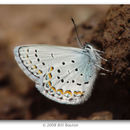North American Ecology (US and Canada)
provided by North American Butterfly Knowledge Network
Resident in Northern North America (Scott 1986). Habitats are Canadian to arctic/alpine zone forest clearings, meadows and tundra. Host plants are usually herbaceous or shrubs with most known hosts from three families: Leguminosae, Empetraceae, and Ericaceae, depending on location. Eggs are laid on or near the host plant singly. Individuals overwinter as eggs. There is one flight each year with the approximate flight time Jun30-Aug15; late July-Aug15 in Newfoundland-Labrador (Scott 1986). Considered synonymous with Plebejus idas by some (Scott 1986).
Conservation Status
provided by University of Alberta Museums
No obvious concerns.
- license
- cc-by-nc
- copyright
- University of Alberta Museums
Cyclicity
provided by University of Alberta Museums
One yearly brood, flying from late June to early September, depending on elevation and habitat.
- license
- cc-by-nc
- copyright
- University of Alberta Museums
Distribution
provided by University of Alberta Museums
Alaska south to California and Colorado, east across the boreal plain to Newfoundland and Labrador (Opler 1999, Layberry et al. 1998).
- license
- cc-by-nc
- copyright
- University of Alberta Museums
General Description
provided by University of Alberta Museums
"This blue has a complete row of orange spots on the hindwing underside, extending onto the forewing (although sometimes faint here). Other species with a full row of hindwing orange spots (Icaricia acmon, I. shasta, Euphilotes ancilla) never have the orange spots extending onto the forewing. This species can be confused with the Melissa Blue (L. melissa) where the ranges overlap in the southern foothills. Idas has narrower orange spots, capped with a black crescent. In Melissa, the orange spots are wider and the black crescents capping the orange spots are flatter, resulting in a more banded appearance. The upperside of idas females can vary from solid brown to mostly purple-blue, and the extent of orange spots varies from none to well-developed. Melissa females always have a solid band of orange, while the strongest-marked Northern females have a row of orange crescents rather than a solid band. It is best to appreciate these differences by looking at more than one individual; uncertain specimens must be dissected for positive identification (see Guppy & Shepard 2001). The specimens illustrated in "Alberta Butterflies" (Bird et al. 1995) as melissa are actually idas.
This group of species has a very muddled taxonomic history in North America; there are likely several species involved under what has been referred to as "idas". In Alberta, southern Mountain populations are subspecies atrapraetextus, while subspecies scudderii supposedly inhabits the central/northern mountain and boreal region (Guppy & Shepard 2001).
Balint and Johnson (1997) in their revision of polyomatine blues place Lycaeides as a subgenus within the larger genus Plebejus."
- license
- cc-by-nc
- copyright
- University of Alberta Museums
Habitat
provided by University of Alberta Museums
Mountain meadows and open pine woodlands.
- license
- cc-by-nc
- copyright
- University of Alberta Museums
Life Cycle
provided by University of Alberta Museums
The early stages of the Northern Blue in North America are undescribed. In Wisconsin, larvae hatch in May after overwintering as an egg, and pass through 3 or 4 instars, pupating in mid June (Wolf 1993). Adult males often form large congregations at moist spots along mountain trails. In the boreal region, Northern Blues are found in jack pine sandhills, close to patches of blueberries (Vaccinium spp.) on which the larvae feed (Wolf 1993, Nielsen 1999).
- license
- cc-by-nc
- copyright
- University of Alberta Museums
Trophic Strategy
provided by University of Alberta Museums
The larval foodplants are not known in western Canada. In Wisconsin and Michigan, caterpillars are dependent on dwarf bilberry (Vaccinium caespitosum) (Wolf 1993, Nielsen 1999).
- license
- cc-by-nc
- copyright
- University of Alberta Museums

